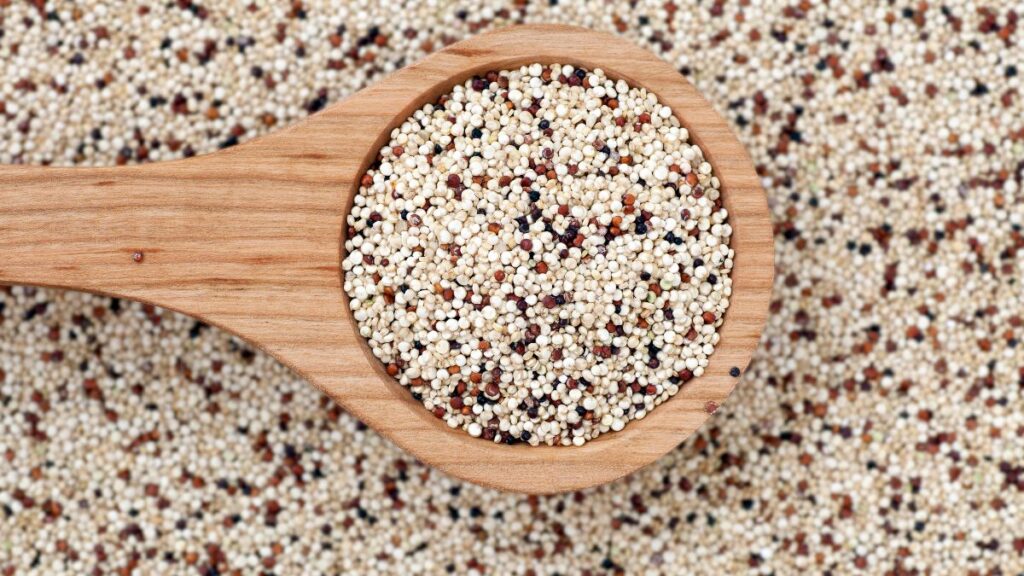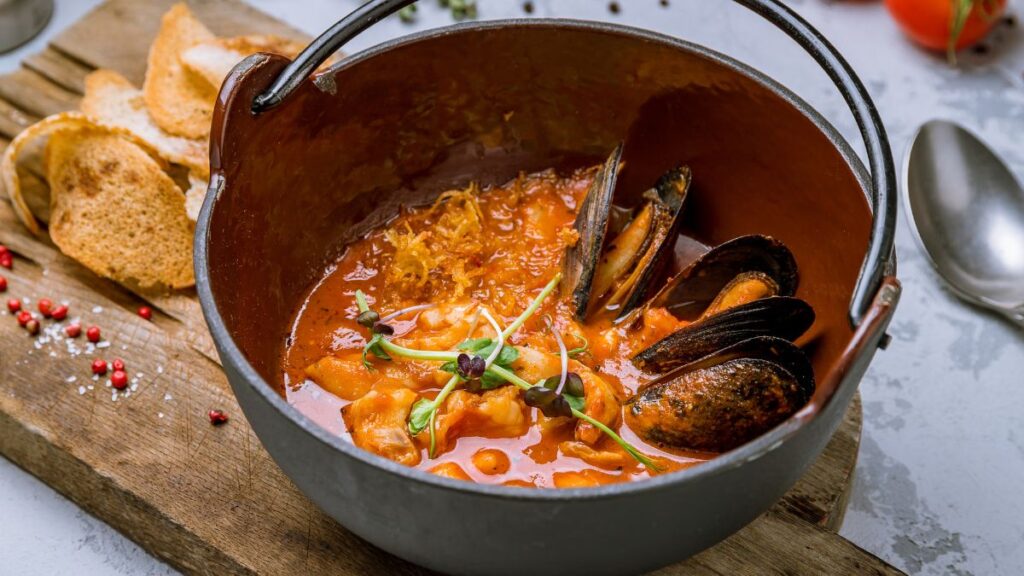15 Foods That Most People Struggle to Pronounce
Many of us encounter unfamiliar foods with names that seem almost impossible to pronounce. Whether they’re international delicacies or unique dishes, these foods can leave us stumbling over our words. If you’ve ever been unsure how to say the name of a dish at a restaurant or in a recipe, you’re not alone.
Some foods have names that can be tricky, even for those who love to explore diverse cuisines. Here are 15 foods that often trip people up when it comes to pronunciation, along with some fun facts about each one.
Quinoa

Quinoa, pronounced “KEEN-wah,” is a grain-like seed that has gained popularity due to its high protein content and versatility. Despite its nutritional benefits, many people still mispronounce it as “kwin-oh-ah” or “keen-o-ah,” which can be confusing.
Originating from the Andes region of South America, quinoa can be used in various dishes, including salads, soups, and as a side dish. It’s a fantastic substitute for rice or pasta, offering a complete protein source that’s also easy to cook. So next time you’re preparing a quinoa recipe, remember it’s “KEEN-wah,” not “kwin-oh-ah.”
Chia Seeds

Chia seeds, pronounced “CHEE-uh,” are tiny powerhouses of nutrition that have become popular in recent years due to their high omega-3 fatty acids and fiber content. They are often mistaken for “CHAI-uh” or “CHY-uh,” which can lead to confusion.
These small seeds are perfect for adding to smoothies, yogurt, and baked goods, and they transform into a gel-like consistency when soaked in liquid. This unique property makes them ideal for puddings and as an egg substitute in vegan recipes. Chia seeds are a versatile ingredient that can enhance your diet with their impressive nutritional profile.
Edamame

Edamame, pronounced “ED-uh-mah-may,” refers to young soybeans typically served as a snack or appetizer. This nutritious bean is often mispronounced as “ed-a-may” or “ed-a-mom,” which can make ordering them at a restaurant a bit challenging.
Edamame is not only a great source of protein but also provides a crunchy, satisfying texture when enjoyed steamed with a sprinkle of sea salt. Commonly featured in Japanese cuisine, these beans are a delightful way to add a healthy snack to your diet. Whether served as an appetizer or mixed into a dish, edamame is both tasty and nutritious.
Balsamic Vinegar

Balsamic vinegar, pronounced “bal-SAM-ik,” is a dark, sweet vinegar often used in salads and marinades. Some people mistakenly pronounce it as “bal-SA-mic” or “bal-SAH-mic,” which can be confusing.
This vinegar originates from Italy and is made from concentrated grape must, which gives it a rich, complex flavor that can elevate a variety of dishes. It is available in both traditional and commercial varieties, with the traditional versions being aged for a more robust taste. Balsamic vinegar’s distinctive flavor profile makes it a popular choice for adding depth to salads and sauces.
Sriracha

Sriracha, pronounced “see-RAH-chah,” is a spicy chili sauce from Thailand that has gained international popularity. It’s often mispronounced as “sree-RAH-chah” or “suh-RAH-chah,” which can be a bit perplexing when discussing recipes or ordering at a restaurant.
Known for its bright red color and fiery kick, Sriracha is a versatile condiment that can be used in a variety of dishes, from soups to stir-fries. Its balance of heat and sweetness makes it a favorite for adding a spicy touch to meals. Embracing the correct pronunciation can help you confidently incorporate this sauce into your cooking.
Bouillabaisse

Bouillabaisse, pronounced “boo-ya-BESS,” is a traditional French seafood stew from the Provence region. It is sometimes mispronounced as “boo-lee-base” or “boo-yah-bayz,” which can make it tricky to order in French restaurants.
This flavorful dish combines various fish and shellfish with herbs and spices, creating a rich and satisfying meal. Bouillabaisse is often served with rouille, a garlic mayonnaise, and crusty bread, enhancing its savory qualities. Its complex flavors and aromatic broth make it a celebrated dish in French cuisine, perfect for seafood lovers.
Miso

Miso, pronounced “MEE-soh,” is a fermented soybean paste used extensively in Japanese cuisine. Some people incorrectly say “MIS-oh” or “MEE-sow,” which can be confusing when discussing recipes.
Miso is a key ingredient in miso soup and can also be used in marinades and dressings to add a savory umami flavor. It comes in different varieties, including white, red, and mixed, each offering its own unique taste. Miso’s versatility and depth of flavor make it a valuable addition to a range of dishes, from soups to sauces.
Ratatouille

Ratatouille, pronounced “ra-ta-TOO-ee,” is a French vegetable stew that often trips people up with its pronunciation. It’s sometimes mispronounced as “rat-a-TOO-lee” or “rat-a-TOO-uh,” which can be a bit confusing.
The dish features a mix of eggplant, zucchini, bell peppers, and tomatoes, all cooked together with herbs to create a comforting and flavorful meal. Ratatouille can be enjoyed hot or cold, and its vibrant mix of vegetables makes it a great way to showcase summer produce. This classic French dish offers a delightful taste of Mediterranean cuisine.
Chimichurri

Chimichurri, pronounced “chee-mee-CHUR-ree,” is an Argentinian sauce made from parsley, garlic, and vinegar. It’s often mispronounced as “chim-uh-CHUR-ee” or “chee-mee-CHUR-ee,” which can lead to confusion when discussing recipes or ordering at a restaurant.
This tangy sauce is typically used to accompany grilled meats, adding a fresh and zesty flavor. It’s easy to make at home and perfect for summer barbecues. Chimichurri’s vibrant taste and versatility make it a popular choice for enhancing various dishes.
Goulash

Goulash, pronounced “GOO-lahsh,” is a hearty stew from Hungary known for its rich flavor and comforting qualities. It can be mistakenly pronounced as “GOO-lash” or “GOW-lash,” which might make communicating difficult when ordering or discussing the dish.
Featuring beef or pork, onions, and paprika, goulash is a satisfying meal often served with potatoes or noodles. Its robust flavor and warming qualities make it a favorite for cold weather. Goulash represents a classic example of Hungarian cuisine and its rich culinary traditions.
Bulgur

Bulgur, pronounced “BUL-gur,” is a whole grain made from cracked wheat. It’s sometimes mispronounced as “BUL-gur” or “BUL-jur,” which can be a bit confusing when talking about recipes or ingredients.
Bulgur is commonly used in Middle Eastern dishes like tabbouleh and pilafs, offering a quick-cooking and nutritious option. It’s rich in fiber and essential nutrients, making it a healthy addition to a variety of meals. Understanding the correct pronunciation can help you confidently include bulgur in your cooking repertoire.
Moussaka

Moussaka, pronounced “moo-SAH-kah,” is a Greek casserole that layers eggplant, meat, and béchamel sauce. It’s often mispronounced as “moo-SAH-ka” or “moo-SAH-kah,” which can make it tricky to discuss.
This baked dish is known for its comforting layers and rich flavors, offering a taste of Mediterranean cuisine. Moussaka is typically enjoyed as a main course and showcases the use of traditional Greek ingredients and cooking techniques. Its savory and satisfying nature makes it a beloved dish in Greek culinary traditions.
Souvlaki

Souvlaki, pronounced “soo-VLAH-kee,” is a popular Greek street food consisting of skewered and grilled meat. It’s sometimes mispronounced as “soo-VLAH-kee” or “soo-VLAH-kee,” which can be confusing when ordering or discussing it.
Souvlaki is often served with pita bread, vegetables, and tzatziki sauce, making it a flavorful and convenient meal option. It’s a staple of Greek cuisine and is enjoyed for its delicious taste and ease of preparation. Correct pronunciation can help you better navigate Greek menus and recipes.
Fennel

Fennel, pronounced “FEN-uhl,” is a vegetable with a distinct licorice-like flavor. It’s frequently mispronounced as “FEN-nel” or “FEHN-nel,” which can be confusing when discussing it in recipes. Fennel can be enjoyed raw, roasted, or used in various dishes such as salads and soups.
Its unique flavor adds a fresh and aromatic quality to meals and is commonly used in Mediterranean cuisine. Understanding the correct pronunciation of fennel can help you confidently incorporate it into your cooking.
Açai

Açai, pronounced “ah-sigh-EE,” is a berry from the Amazon rainforest renowned for its antioxidant properties. It’s often mispronounced as “ah-kai” or “ah-sah-EE,” which can make it tricky when discussing smoothie bowls or juices.
Açai is often featured in smoothie bowls and health drinks due to its unique flavor, which combines hints of berries and chocolate. It offers a nutritious boost and is popular in health-conscious diets.
15 Places Where You’re Expected to Tip—But You Really Don’t Have To

Tipping has become a widespread practice in many industries, with the expectation that you’ll leave a little extra for good service. However, not every situation truly warrants a tip, even if you feel pressured to give one.
15 Places Where You’re Expected to Tip—But You Really Don’t Have To
15 Most Annoying Habits of American Tourists When Dining Abroad

Traveling abroad is an exciting adventure, and dining in new places is a big part of the experience. However, some common behaviors by American tourists can be frustrating for locals and affect the dining experience.
15 Most Annoying Habits of American Tourists When Dining Abroad







